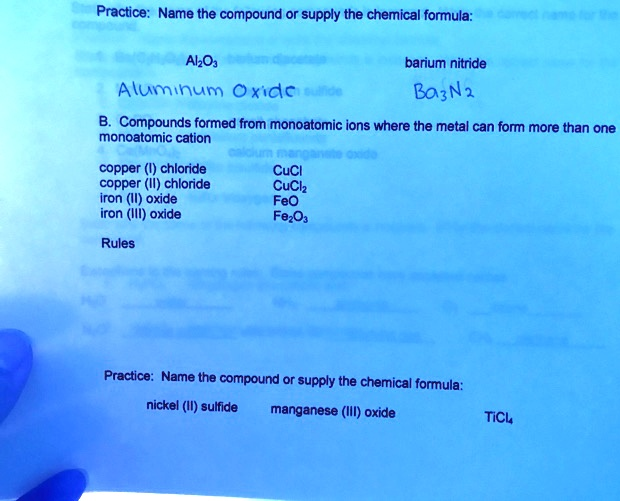
The Correct Answer and Explanation is:
Based on the chemistry principles shown on the worksheet, here are the correct answers for the practice problems at the bottom of the page:
- nickel (II) sulfide: NiS
- manganese (III) oxide: Mn₂O₃
- TiCl₄: titanium (IV) chloride
Explanation
These problems involve naming ionic compounds and writing their chemical formulas, particularly for metals that can form more than one type of positive ion (cation). The key is to ensure the total positive charge from the metal cations balances the total negative charge from the nonmetal anions, making the overall compound electrically neutral.
For nickel (II) sulfide, the name tells us the specific ions involved. “Nickel (II)” indicates the nickel cation has a charge of +2, written as Ni²⁺. “Sulfide” is the name for the ion of sulfur (S), which is in Group 16 of the periodic table and consistently forms an anion with a -2 charge, S²⁻. Since the positive charge (+2) and the negative charge (-2) are equal and opposite, the ions combine in a simple one to one ratio to achieve neutrality. Therefore, the chemical formula is NiS.
For manganese (III) oxide, we follow a similar process. “Manganese (III)” signifies the manganese cation with a +3 charge, which is Mn³⁺. “Oxide” refers to the oxygen anion, O²⁻. Here, the charges are not equal. To find the correct ratio, we find the least common multiple of the charges 3 and 2, which is 6. To get a total positive charge of +6, we need two manganese ions (2 x +3 = +6). To get a total negative charge of -6, we need three oxide ions (3 x -2 = -6). This balance of charges gives us the chemical formula Mn₂O₃.
To name TiCl₄, we must first determine the charge of the titanium (Ti) ion. Titanium is a transition metal, so it requires a Roman numeral in its name. We know that chlorine, a halogen, forms the chloride anion with a -1 charge (Cl⁻). The subscript 4 in the formula indicates there are four chloride ions. The total negative charge is 4 multiplied by -1, which equals -4. To balance this, the single titanium ion must have a charge of +4. Thus, we have the Ti⁴⁺ cation. The name is constructed by writing the metal’s name (titanium), followed by its charge in Roman numerals in parentheses (IV), and finally the anion’s name (chloride). The correct name is titanium (IV) chloride.thumb_upthumb_down
